Table of Contents
Ever stood in the kitchen, pancake mix in hand, and wondered if you could whip up something a little more…French? You're not alone. The eternal breakfast debate of pancake recipe vs crepe has puzzled many a hungry soul. Both are undeniably delicious, yet they occupy distinct spaces in the culinary world. Are they really that different, or is it all just clever marketing? Let's face it, both start with a batter and end up on a hot pan, but the similarities pretty much stop there.
Pancake Recipe vs Crepe: What Sets Them Apart?
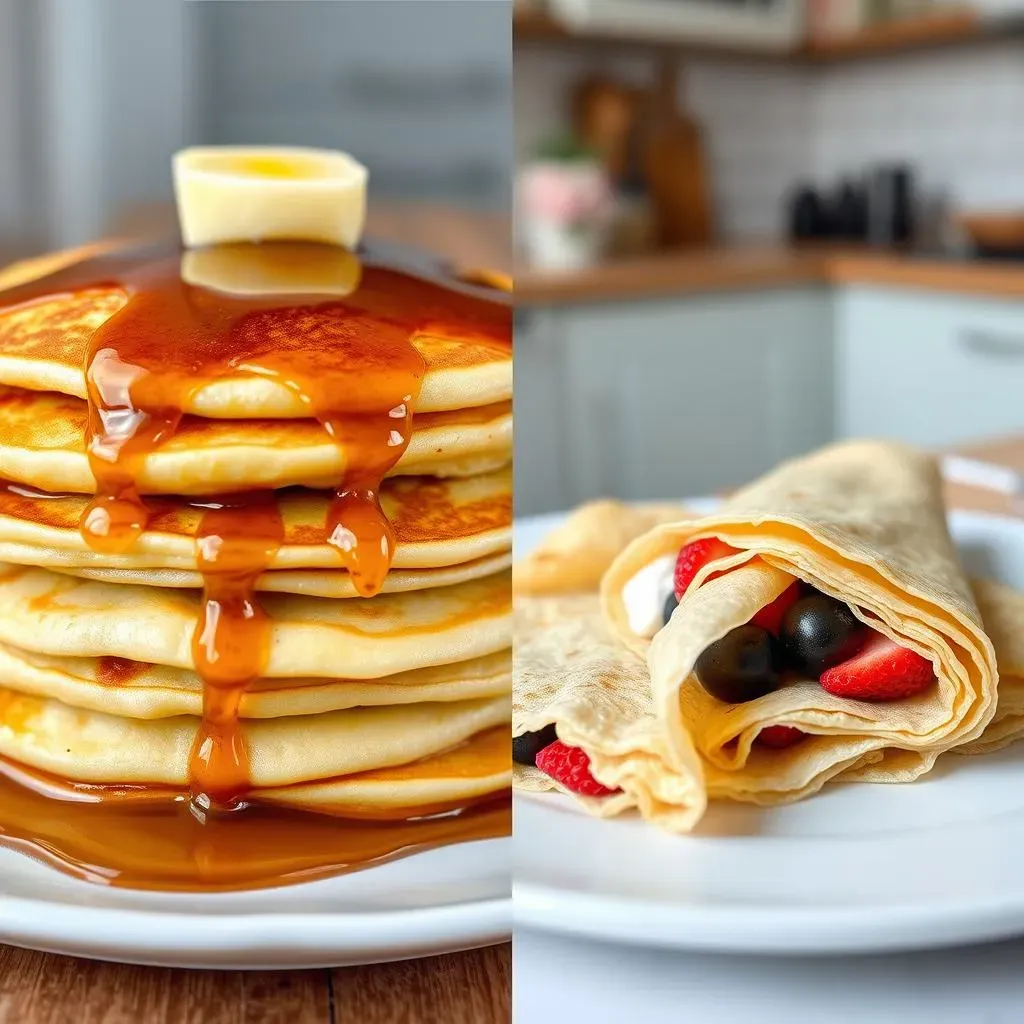
Pancake Recipe vs Crepe: What Sets Them Apart?
so you're staring down a craving and trying to decide: pancake or crepe? The first thing to know is that while they both hail from the same family of flat, cooked batter, they're far from identical twins. Think of pancakes as the fluffy, all-American breakfast staple, while crepes are their sophisticated, thin, and versatile European cousin. The core difference lies in their purpose. Pancakes are designed to be a vehicle for butter, syrup, and all things breakfast-y, while crepes are a blank canvas, ready to be filled with sweet or savory delights. It's like the difference between a burger and a wrap—same basic ingredients, totally different vibe. So, what exactly makes them so distinct?
It all boils down to the batter and the cooking technique. Pancake batter tends to be thicker, thanks to the inclusion of leavening agents like baking powder or baking soda. This gives pancakes their signature rise and fluffy texture. Crepe batter, on the other hand, is thin and runny, lacking any leavening agents. This results in a delicate, almost lace-like texture. The cooking process further accentuates these differences. Pancakes are cooked on a griddle or frying pan, flipping once to achieve a golden-brown exterior and a cooked-through interior. Crepes are cooked in a thin layer on a specialized crepe maker or a non-stick pan, requiring a swirling motion to spread the batter evenly. The goal is to create a paper-thin layer that's lightly golden and slightly crispy around the edges.
Feature | Pancakes | Crepes |
|---|---|---|
Batter Thickness | Thick | Thin |
Leavening Agent | Yes (baking powder/soda) | No |
Texture | Fluffy, soft | Thin, delicate |
Cooking Method | Griddle/frying pan | Crepe maker/non-stick pan |
Typical Use | Breakfast with syrup | Sweet or savory fillings |
Batter Up: Key Ingredients in Pancake and Crepe Recipes
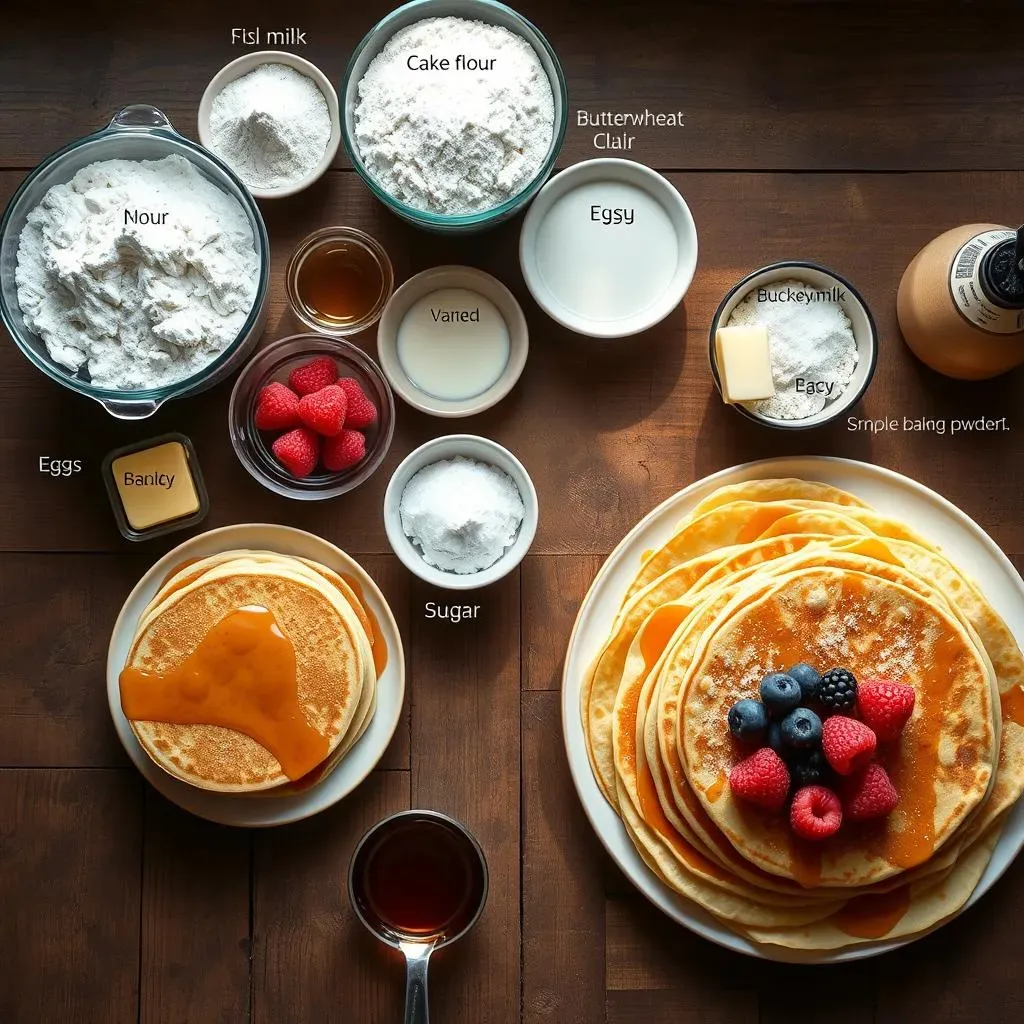
Batter Up: Key Ingredients in Pancake and Crepe Recipes
The Foundation: Flour Power
let's talk flour. Both pancakes and crepes start with this humble ingredient, but the type of flour you choose can make a difference. All-purpose flour is the go-to for most recipes, providing a good balance of structure and tenderness. However, for pancakes, some folks swear by using cake flour or pastry flour for an extra-light and fluffy texture. For crepes, you might consider using buckwheat flour for a more rustic, nutty flavor, especially if you're planning a savory filling. It adds a certain "je ne sais quoi," you know?
Experimenting with different flours can be a fun way to tweak your recipes and discover new flavor profiles. Just remember that different flours have different protein contents, which can affect the amount of liquid you need to add to your batter. So, start with the recommended amount and adjust as needed until you reach the desired consistency.
Liquid Assets: Milk, Water, or Something Else?
Next up, the liquid. Milk is the classic choice for both pancake and crepe batters, adding richness and moisture. However, you can also use water, buttermilk, or even a combination of liquids to achieve different results. Buttermilk, for instance, adds a tangy flavor and helps to create a more tender crumb in pancakes. Some crepe recipes call for a splash of beer or sparkling water to create a lighter, more delicate texture. The key is to experiment and find what works best for your taste.
When adding the liquid to your batter, do it gradually and whisk constantly to avoid lumps. Nobody wants a lumpy pancake or crepe! If you do end up with a few lumps, don't panic. Just let the batter rest for a few minutes, and the lumps should dissolve on their own. Or, you can use an immersion blender to smooth things out.
The Supporting Cast: Eggs, Fat, and Flavor
Finally, let's talk about the supporting ingredients that add flavor and complexity to your pancake and crepe recipes. Eggs are essential for binding the ingredients together and adding richness. Melted butter or oil adds moisture and helps to create a tender texture. And, of course, a pinch of salt enhances the flavors of all the other ingredients.
For pancakes, a touch of sugar or vanilla extract can add sweetness and aroma. For crepes, you might consider adding a splash of orange liqueur or a pinch of cinnamon for a more sophisticated flavor. And don't forget the leavening agents! Baking powder or baking soda is what gives pancakes their signature rise and fluffy texture. Without it, you'll end up with flat, sad pancakes. Nobody wants that.
The Cooking Process: Achieving Pancake Fluff vs. Crepe Thinness
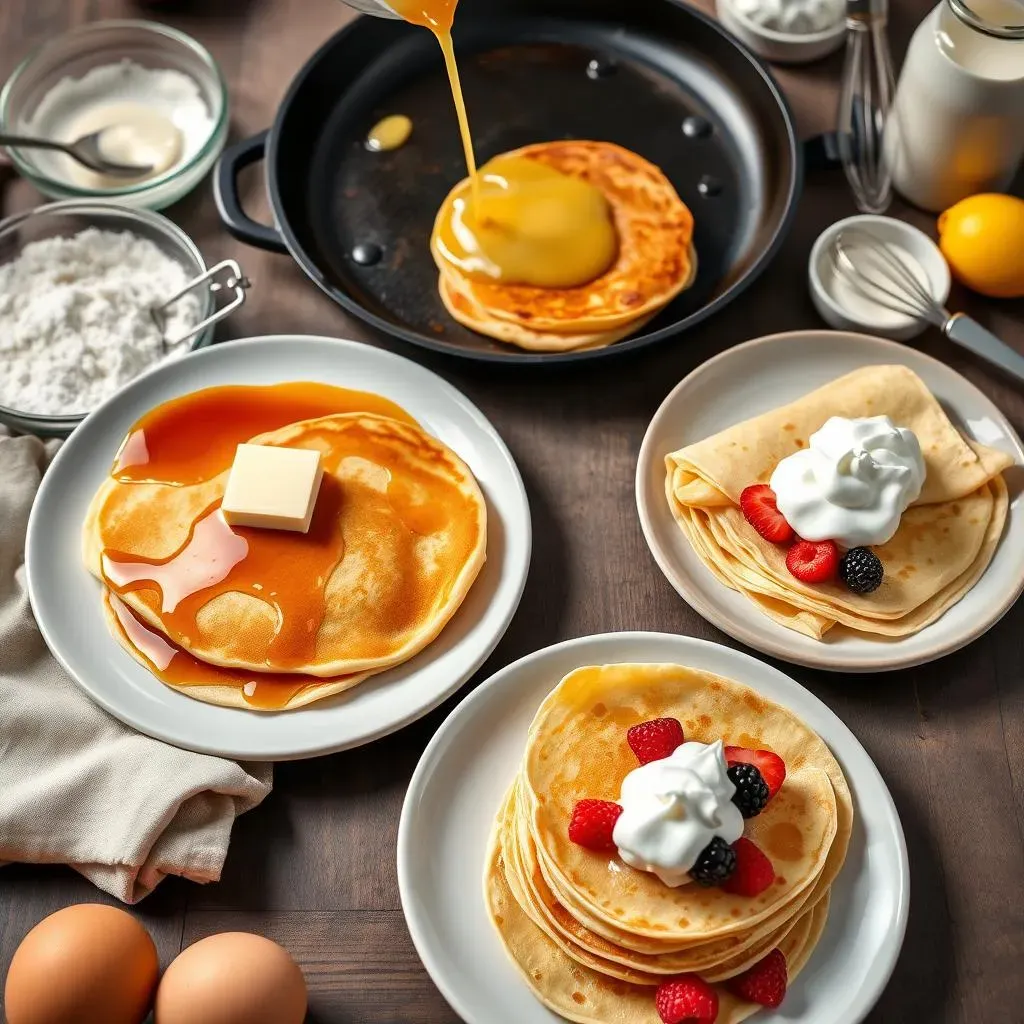
The Cooking Process: Achieving Pancake Fluff vs. Crepe Thinness
Heat and Grease: Setting the Stage
Alright, let's get down to the nitty-gritty of cooking. For pancakes, it's all about that medium-hot griddle. You want it hot enough to get a nice golden-brown color, but not so hot that the pancakes burn before they're cooked through. A lightly greased surface is key – butter, oil, or cooking spray all work. The grease prevents sticking and helps create that desirable crispy edge. For crepes, you'll want a slightly lower heat, around medium. A non-stick crepe pan or a well-seasoned non-stick skillet is your best friend here. The goal is to cook the crepe quickly and evenly, without it sticking or tearing.
One crucial difference lies in how you apply the batter. For pancakes, you want to pour or scoop the batter onto the hot griddle, forming individual circles. Don't overcrowd the pan! Give each pancake enough space to spread out and cook evenly. For crepes, you'll need to pour a small amount of batter into the center of the pan and immediately swirl it around to create a thin, even layer. This takes a bit of practice, but once you get the hang of it, you'll be cranking out crepes like a pro.
The Flip Factor: Patience is a Virtue
Patience is key in both pancake and crepe making. For pancakes, wait until bubbles start to form on the surface and the edges look set before flipping. This usually takes a few minutes per side. Resist the urge to flip them too early, or you'll end up with sad, deflated pancakes. For crepes, you'll know it's time to flip when the edges start to lift away from the pan and the surface looks dry. Use a thin spatula to gently lift one edge and flip the crepe over. Cook for another minute or so, until lightly golden on the second side.
Technique Tweaks: Mastering the Art
Mastering the art of pancake and crepe making takes practice, but here are a few technique tweaks to help you along the way. For extra-fluffy pancakes, try separating the eggs and whipping the egg whites to stiff peaks before folding them into the batter. This adds air and lightness. For perfectly thin crepes, make sure your batter is smooth and lump-free. If you're having trouble spreading the batter evenly, try adding a tablespoon or two of water to thin it out.
Don't be discouraged if your first few pancakes or crepes don't turn out perfectly. It takes a bit of experimentation to find the right heat, batter consistency, and cooking time. Just keep practicing, and you'll be a pro in no time. And remember, even imperfect pancakes and crepes still taste delicious!
Aspect | Pancakes | Crepes |
|---|---|---|
Griddle Temperature | Medium-Hot | Medium |
Greasing | Lightly greased | Non-stick pan preferred |
Batter Application | Pour/scoop | Pour and swirl |
Flip Timing | When bubbles form | When edges lift |
Goal | Golden-brown, cooked through | Thin, even, lightly golden |
Pancake Recipe and Crepe: Toppings and Flavor Combinations
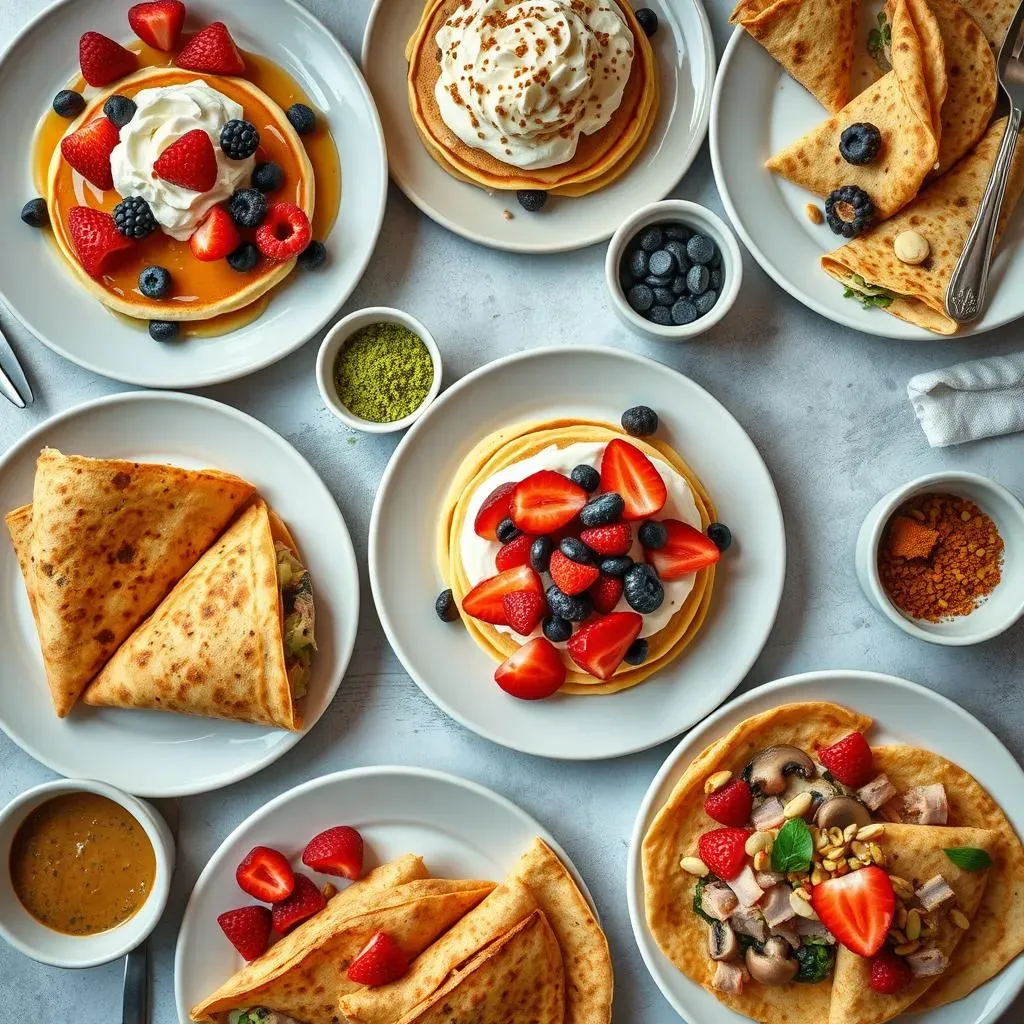
Pancake Recipe and Crepe: Toppings and Flavor Combinations
Sweet Sensations: Classic Pancake and Crepe Toppings
Let's be honest, the toppings are where the real fun begins! For pancakes, you can't go wrong with the classics: butter, maple syrup, whipped cream, and fresh berries. But why stop there? Chocolate chips, chopped nuts, bananas, and even a scoop of ice cream can take your pancakes to the next level. For crepes, the possibilities are endless. Nutella and strawberries are a match made in heaven, but you can also try lemon curd, jam, or a dusting of powdered sugar. Get creative and experiment with different flavor combinations – you might just discover your new favorite!
Consider the texture as well as the flavor. A dollop of Greek yogurt adds a tangy creaminess, while a sprinkle of granola provides a satisfying crunch. And don't forget the sauces! Chocolate sauce, caramel sauce, and fruit compotes are all delicious options. The key is to balance the sweetness and acidity to create a harmonious flavor profile.
Savory Spectacles: Elevating Crepes Beyond Breakfast
Crepes truly shine when you venture into savory territory. Think of them as a blank canvas for all sorts of delicious fillings. Ham and cheese is a classic combination, but you can also try spinach and ricotta, mushrooms and Gruyère, or even smoked salmon and cream cheese. For a heartier meal, add some cooked chicken, beef, or vegetables. The key is to choose fillings that complement each other and create a balanced flavor profile. Don't be afraid to experiment with different sauces and spices to add extra depth and complexity.
Savory crepes are perfect for lunch, dinner, or even a light snack. They're also a great way to use up leftover ingredients. Simply toss whatever you have on hand into a crepe, and you've got a delicious and satisfying meal. And don't forget the toppings! A sprinkle of fresh herbs, a dollop of sour cream, or a drizzle of olive oil can elevate your savory crepes to gourmet status.
Global Gastronomy: International Flavors for Pancakes and Crepes
Why limit yourself to traditional toppings when you can explore the flavors of the world? For pancakes, try adding a scoop of matcha powder to the batter for a Japanese-inspired treat. Top with red bean paste and mochi for an authentic experience. Or, try adding some spices like cinnamon, cardamom, and ginger for a Middle Eastern-inspired pancake. Drizzle with honey and sprinkle with chopped pistachios for a truly decadent treat.
Cuisine | Pancake/Crepe Flavor | Topping Ideas |
|---|---|---|
Japanese | Matcha | Red bean paste, mochi |
Middle Eastern | Spiced (cinnamon, cardamom) | Honey, pistachios |
Mexican | Chocolate & Chili | Whipped cream, cinnamon |
Italian | Ricotta & Lemon | Berries, powdered sugar |
For crepes, try making a Mexican-inspired filling with seasoned ground beef, black beans, and salsa. Top with guacamole and sour cream for a fiesta in your mouth! Or, try a Thai-inspired filling with coconut milk, curry paste, and vegetables. Top with peanuts and cilantro for a flavorful and exotic crepe. The possibilities are endless – let your imagination run wild!
Crepe vs Pancake: Which One Should You Choose?
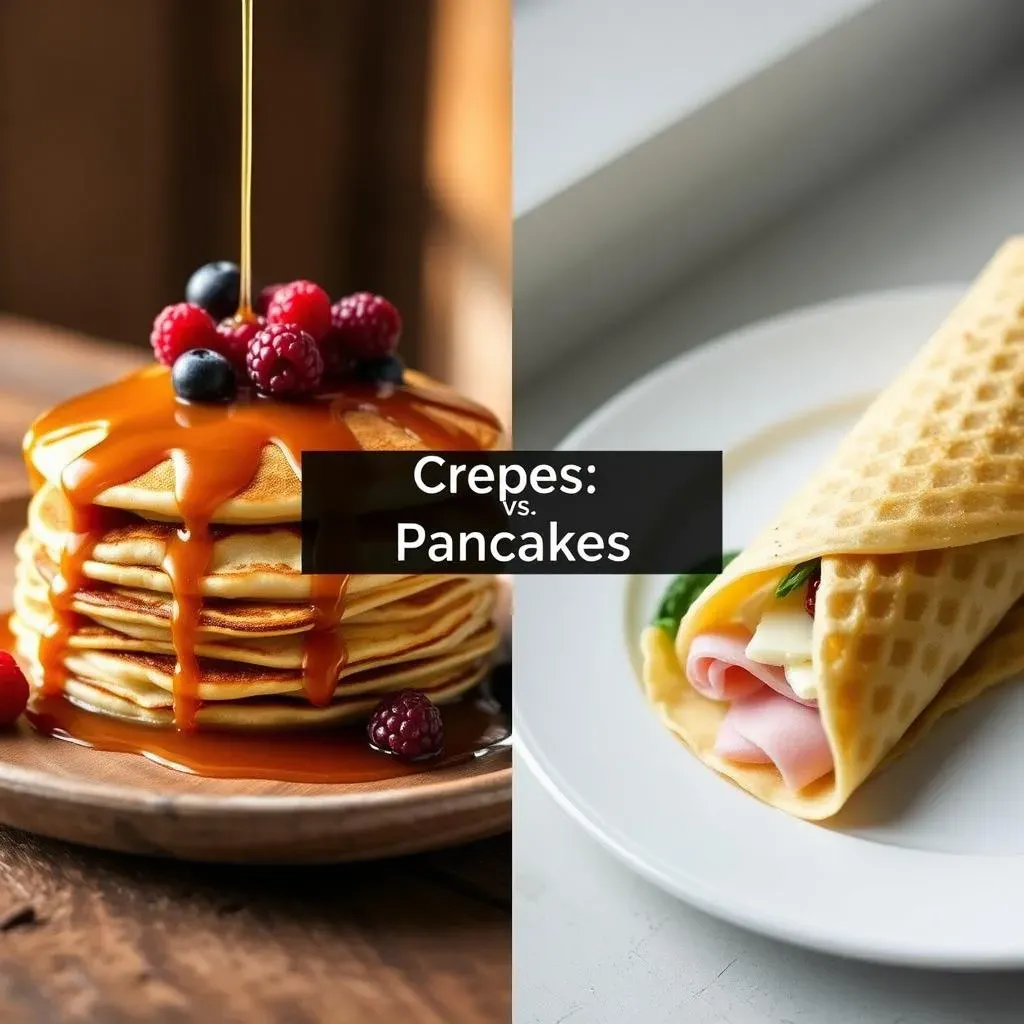
Crepe vs Pancake: Which One Should You Choose?
Consider the Occasion
So, you're standing at the crossroads of breakfast, pondering the age-old question: crepe vs pancake? The truth is, there's no right or wrong answer – it all depends on the occasion and what you're in the mood for. Are you looking for a quick and easy breakfast that will satisfy your sweet tooth? Pancakes are your go-to. They're fluffy, comforting, and perfect for soaking up syrup. But if you're aiming for something a bit more sophisticated, or want a meal that can swing both sweet and savory, crepes are your champion.
Think about it this way: pancakes are the casual weekend brunch, while crepes are the elegant dinner party. Pancakes are the jeans and t-shirt, crepes are the little black dress. Pancakes are the burger and fries, crepes are the gourmet sandwich. You get the picture. The beauty of both lies in their adaptability, but their inherent nature lends themselves to different scenarios.
Sweet Tooth vs. Savory Craving
Another crucial factor to consider is your craving. Are you in the mood for something sweet or savory? Pancakes are typically associated with sweet toppings, like syrup, fruit, and whipped cream. While you can certainly add savory elements to pancakes, they're generally best suited for sweet flavors. Crepes, on the other hand, are incredibly versatile and can be filled with just about anything. From sweet Nutella and bananas to savory ham and cheese, the possibilities are endless. This makes crepes a great option if you're looking for a meal that can satisfy both sweet and savory cravings.
Imagine waking up with a serious sweet tooth. Fluffy pancakes, drowned in maple syrup, are calling your name. But what if you're craving something a little more substantial? A savory crepe, filled with eggs, bacon, and cheese, might be just what you need. Or, maybe you want to start with a savory crepe and finish with a sweet one for dessert. With crepes, you can have it all!
Time and Technique: How Much Effort Are You Willing to Put In?
Finally, consider the time and effort you're willing to put in. Pancakes are generally quicker and easier to make than crepes. The batter is simple to whip up, and the cooking process is straightforward. Crepes, on the other hand, require a bit more finesse. The batter needs to be thin and smooth, and the cooking process takes some practice to master. You'll need a good non-stick pan or a crepe maker, and you'll need to be patient as you swirl the batter and cook each crepe to perfection.
So, if you're short on time or just looking for a simple breakfast, pancakes are the way to go. But if you're willing to invest a little more time and effort, crepes can be a truly rewarding culinary experience. And remember, even imperfect crepes still taste delicious! Ultimately, the choice between crepe vs pancake is a personal one. Consider the occasion, your cravings, and your available time, and you'll be sure to make the right decision. Happy cooking!
Factor | Pancakes | Crepes |
|---|---|---|
Typical Use | Breakfast with syrup | Sweet or savory fillings |
Time and Effort | Quicker and Easier | More Finesse Required |
Flavor Profile | Mostly Sweet | Sweet and Savory |
Occasion | Casual Brunch | Elegant Dinner Party |
The Great Pancake Recipe vs Crepe Showdown: A Delicious Verdict
So, which reigns supreme in the battle of pancake recipe vs crepe? The truth is, there's no single winner. Both offer unique culinary experiences, satisfying different cravings and suiting various occasions. Pancakes bring a comforting, fluffy indulgence to the breakfast table, while crepes offer a lighter, more versatile canvas for both sweet and savory creations. Ultimately, the choice boils down to personal preference and the specific dish you're aiming to create. Whether you're flipping a stack of golden pancakes or swirling a delicate crepe in a pan, the most important ingredient is always a dash of love and a sprinkle of creativity. Now, go forth and conquer your kitchen, armed with the knowledge to master both these delightful dishes!